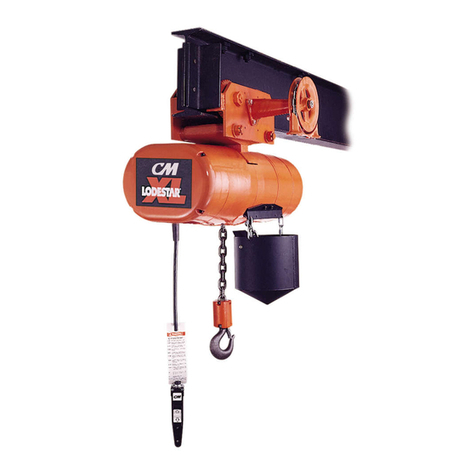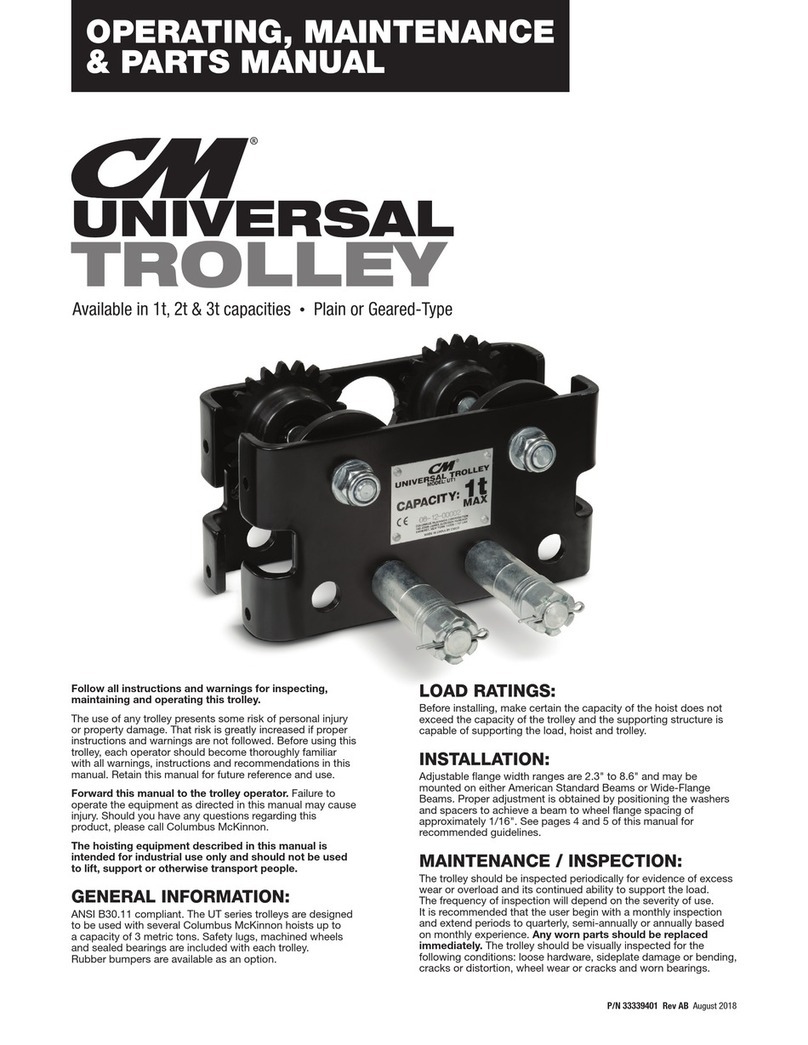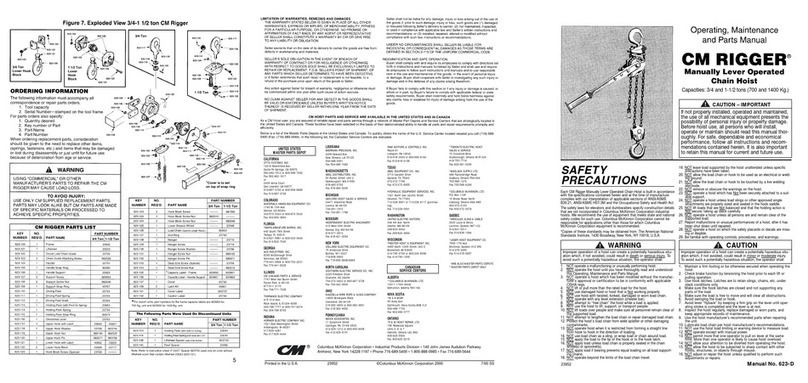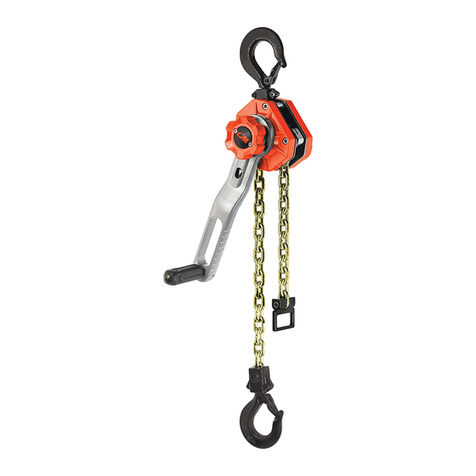
A
WARNING
Malfunction of unit, rigging slip or loss of footing may cause
user to slip resulting
in
injury.
TO
AVOID
IN.JURY:
Always have a firm and secure footing when using the Series
637 Lever Hoist.
Inspect Hoist -Before each use and at specified
intervals as directed
in
inspection section.
WARNING
Use as directed above. Failure to do so may cause injury to
you or others.
1.
Do not exceed capacity shown on the identification plate.
2.
Do not use to lift people or loads over people.
3.
Do not use unless the Hoist's frame and chain form a
straight line between hooks.
4.
Do not use if the frame is
in
contact with any object.
5.
Do not use if the unit is damaged or malfunctions.
6.
Do not use extension
on
lever. Use hand power only.
7.
Do not use if chain is twisted, kinked or damaged.
Safety Procedures
1.
The hoist must
be
kept clean to assure proper
opertion. Before use, check to
be
sure the load chain
is
clean, that there
is
no
foreign material
in
the liftwheel
area and that the lever operates freely.
2.
When preparing to pull or tension a load,
be
sure the
attachment to each hook is firmly seated
in
the hook
saddle. Avoid off-center loading of any kind, especially
loading
on
the tip of the hook.
A
WARNING
ALLOWING THE LOAD TO BEAR AGAINST THE HOOK
LATCH AND/OR HOOK TIP CAN RESULT
IN
LOSS OF LOAD.
TO
AVOID
IN.JURY:
DO
NOT ALLOW THE LOAD TO BEAR AGAINST THE HOOK
LATCH AND/OR HOOK
TIP.
APPLY LOAD TO HOOK BOWL
OR
SADDLE
ONLY.
3.
When pulling or tensioning, move the load only enough
to slightly load the unit, then check to
be
sure that the
attachments to the hooks and load are firmly seated.
Continue movement only after you are assured the
load
is
free of
all
obstructions.
4.
Do
not load beyond the rated capacity. Overload
can
cause immediate failure or cause damage resulting
in
future failure, even at less than rated capacity.
5.
The hoist has been designed for hand powered
operation
only.
Do
not use
an
extension
on
the lever.
Lever pulls of 35 pounds(15.9Kg.)
on
the 3/4 ton unit,
40 pounds(18.1Kg.)
on
the 1-1/2 ton unit, 73
pounds(33.1 Kg.)
on
the 3 ton unit and 77
pounds(34.9Kg.)
on
the 6
ton
unit, will result
in
rated capacity
on
the unit. Any greater pull
is
an
indication of either
an
overload or
an
incorrectly
maintained unit.
A
WARNING
POWER OPERATION
MAY
CAUSE DAMAGE OR PRE-
MATURE WEAR THAT
IN
TURN MAY CAUSE A PART TO
BREAK AND ALLOW THE LOAD TO FALL.
TO
AVOID
IN.JURY:
OPERATE THE HOIST USING HAND POWER ONL
Yi
6.
Do
not use this hoist or any other material handling
equipment for lifting or moving people, or lifting loads
over people.
7.
Stand clear of
all
loads and warn other people of your
intention to move a load
in
their area.
8.
Do
not leave a load
on
the unit unattended.
9.
Do
not take
up
the load chain to the point where the
end ring or lower hook block becomes jammed
against the frame.
10.
Read warnings
and
instructions
on
the lever before
each use.
11.
Do
not wrap the load chain around the load and hook
onto itself as a choker chain sling or bring the load
in
contact with the hoist. Doing this will result
in
the
loss of the swivel effect of the hook which could
result
in
twisted chain and a jammed liftwheel. Also,
the chain may
be
damaged at the hook.
12.
Do
not hold the load chain while operating the hoist.
Should the hoist not operate properly, serious injury
may occur.
13.
Do
not operate the hoist unless
it
is
rigged to pull
in
a
straight line from hook to hook, and the frame is free
to swivel
on
the upper hook. Refer to Figure
2.
14.
When there
is
a load
on
the hoist, do not pull or turn
the free chaining knob. Doing this will allow the
load to
be
released
in
a sudden and uncontrolled
manner and may cause injury to you and/or property
damage.
15.
Never operate the hoist when flammable materials or
vapors are present. Contact between metal parts
may produce sparks that can cause a fire or
explosion.
16.
STAY
ALERT! Watch what you are doing and use
common sense.
Do
not use the hoist when you are
tired, distracted or under the influence of drugs,
alcohol or medication causing diminished control.
INSPECTION
AND
MAINTENANCE
INSPECTION
To
maintain continuous and satisfactory operation, a
regular inspection procedure must
be
initiated so that
worn or damaged parts can
be
replaced before they
become unsafe. The intervals of inspection must
be
determined
by
the individual application and are based
upon the type of service to which the hoist
is
subjected.
The intervals indicated below are based
on
normal
service.
The inspections are divided into two general
classifications designated as "frequent" and "periodic".
Frequent Inspections
These inspections are usually visual examinations
by
the
operator. Frequent inspections are to
be
performed daily
or before each use and they are to include:
a.
Braking mechanism for evidence of slippage.
S
b.
Operation of the directional lever for free movement.
c.
Load chain for lubricant, wear, damaged links or
foreign material.
d.
Hooks for damage, cracks, twists, latch engagement
and latch operation.
Periodic Inspections
These are visual inspections of external and internal
conditions
by
a designated person making records to
provide the basis for continuing evaluation of the
condition of the tool. The periodic inspection should
include those items listed under frequent inspection as
well as the following:
a.
Chain for excessive wear or stretch (see page
6)
every three months.
b.
Worn, cracked or distorted parts such as lower hook
block, upper hook block, upper hook pin, chain guide
roller, stripper, side plates, gear cover, gears,
bushings, lever, brake cover, free chaining knob,
ratchet hub pawl, cam guide, friction hub and lever
ratchet hub -every three months.
c.
Inspect for wear
on
the tip of the pawls, teeth of the
ratchet, and pockets of the liftwheel -every three
months.
































